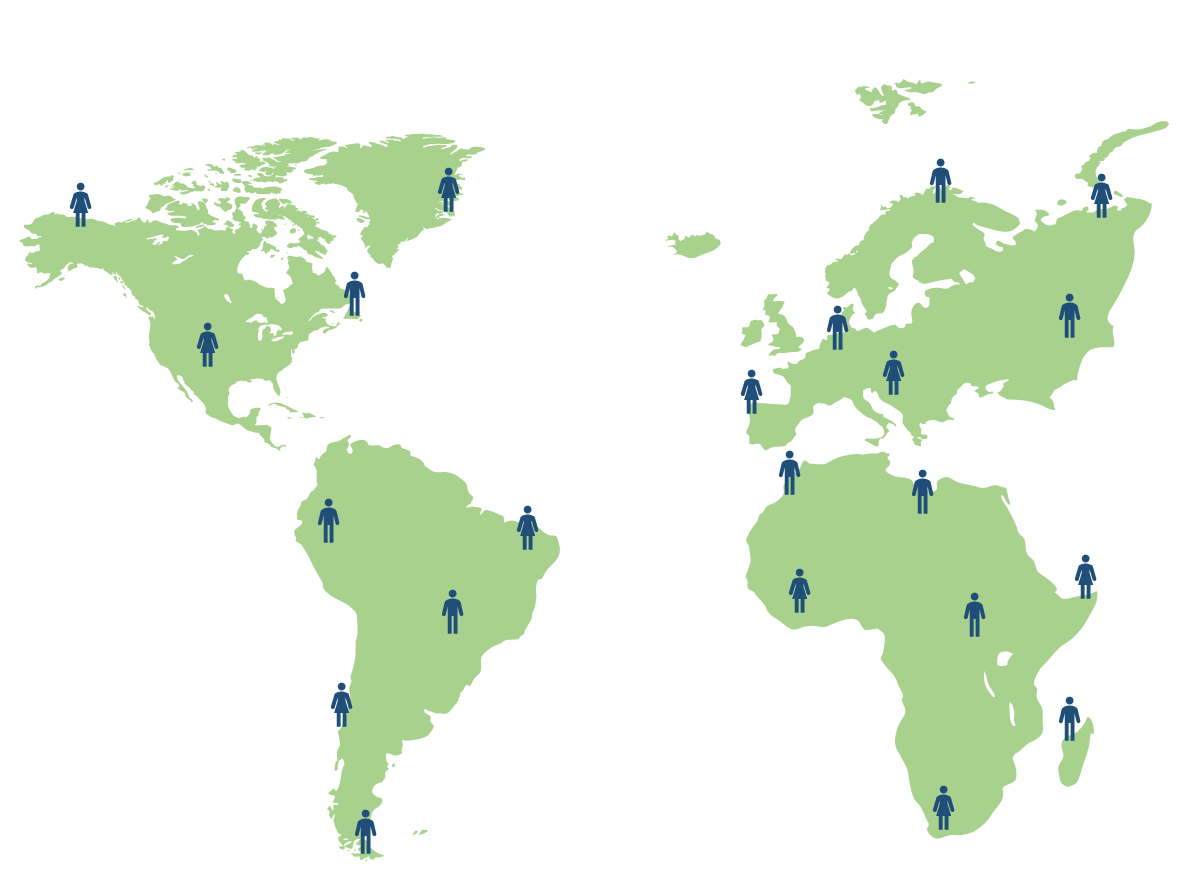
In the 1990s the first gene associated with Parkinson’s disease, SNCA, was discovered in families from Greece and Italy. Since then, we have learned that disease-causing variants (also called gene changes or mutations) in other genes are also associated with Parkinson’s disease and these are found worldwide.
Some genes are associated with late-onset Parkinson’s disease (50 years and older), versus early-onset Parkinson’s disease (less than 50 years). It is important to distinguish late and early onset since they are often associated with different genes, inheritance patterns and symptoms. It is more likely to find a variant in individuals who have multiple relatives with Parkinson’s disease. However, gene variants can also be found in individuals who do not have a family history of Parkinson’s disease.
If you have had genetic testing for Parkinson’s disease, it can be helpful to share your results with family members. Click here for a printable sheet on sharing test results with family members.
Genes
The SNCA gene provides instructions for making alpha-synuclein, a protein with an important role in Parkinson’s disease. Different types of variants in SNCA may cause varying degrees of disease severity. Some forms of SNCA-associated Parkinson’s disease may have atypical symptoms, and cognitive and psychiatric features may be more common. Other variants are associated with more classic symptoms of Parkinson’s disease. Earlier age of onset (before age 50 years) may also be a feature of SNCA variants. In general, SNCA variants are a rare cause of Parkinson’s disease.
SNCA variants are inherited in an autosomal dominant fashion. This means that a person only needs to inherit one SNCA gene variant to have Parkinson’s disease or the associated risk of Parkinson’s disease. This also means that both males and females can pass on and inherit the variant. Each child of a person with a SNCA variant has a 50% (or 1 in 2) chance to inherit the variant. Similarly, this individual has a 50% (or 1 in 2) chance to not inherit the variant from their parent. Not everyone with a SNCA variant will develop Parkinson’s disease; this is called incomplete penetrance.
Individuals with LRRK2 gene variants have a higher risk of developing Parkinson’s disease than the general population, and this risk may vary depending on the type of variant. Risk of Parkinson’s disease increases with age. However, many people with a LRRK2 variant do not develop Parkinson’s disease; this is called incomplete penetrance. It is likely other risk factors are needed for an individual to develop Parkinson’s disease in addition to a LRRK2 gene variant.
LRRK2 variants are inherited in an autosomal dominant fashion. This means that a person only needs to inherit one LRRK2 gene variant to have an increased risk of Parkinson’s disease. This also means that both males and females can pass on and inherit the variant. Each child of a person with a LRRK2 variant has a 50% (or 1 in 2) chance to inherit the variant. Similarly, this individual has a 50% (or 1 in 2) chance to not inherit the variant from their parent.
Several variants have been reported in the LRRK2 gene that can contribute to Parkinson’s disease risk. One important variant is the LRRK2 G2019S variant. Approximately 1-2% of individuals with Parkinson’s disease have the LRRK2 G2019S variant. However, among some ethnic groups the frequency may by higher. For example, in groups who are of Eastern European (Ashkenazi) Jewish descent, approximately 15% of individuals with Parkinson’s disease have this variant. LRRK2 variants can be found in people of nearly any ancestry and genetic testing can determine if a person carries a particular LRRK2 variant.
Individuals with one or two GBA1 gene variants have a higher risk of developing Parkinson’s disease than the general population. The risk of Parkinson’s disease increases with age and may vary depending on the type of variant and whether one or two variants are present. However, many people with a GBA1 variant do not develop Parkinson’s disease; this is called incomplete penetrance. It is likely other risk factors are needed for an individual to develop Parkinson’s disease in addition to a GBA1 gene variant.
For Parkinson’s disease, GBA1 variants are inherited in an autosomal dominant fashion. This means that a person only needs to inherit one GBA1 gene variant to have an increased risk of Parkinson’s disease. This also means that both males and females can pass on and inherit the variant.
Variants in the GBA1 gene are inherited (or passed on) through families, and therefore each child of a person with a GBA1 variant has a 50% (or 1 in 2) chance to inherit the variant. Similarly, this individual has a 50% (or 1 in 2) chance to not inherit the variant from their parent. Only one GBA1 variant is needed to have a risk of Parkinson’s disease. Having two GBA1 gene variants is associated with a risk of Parkinson’s disease, as well as a condition call Gaucher disease (see below).
Variants in the GBA1 gene are the most common genetic factor currently associated with Parkinson’s disease. Of individuals with Parkinson's disease, approximately 20% of people with Ashkenazi Jewish ancestry will carry a GBA1 variant, while about 7% of individualist with non-Jewish ancestry will carry a GBA1 variant. Over 300 different GBA1 variants have been identified. There is a very common GBA1 variant called N370S that makes up 70% of all reported GBA1 variants in the Ashkenazi Jewish population.
Two unique GBA1 variants, T369M and E326K, have recently been reported. These variants are considered susceptibility factors for Parkinson’s disease, and more research is needed to better understand how they impact the risk for Parkinson’s disease. Both variants are commonly found in the general population, and do not appear to cause Gaucher disease.
Click here for a printable GBA1 factsheet.
Gaucher disease
When an individual has a variant in both GBA1 genes, they will usually have a condition called Gaucher disease. Symptoms of Gaucher disease include enlarged spleen/liver, abnormal blood cell counts, bone pain, fractures and, in some cases, neurologic problems. There are three recognized types of Gaucher disease. Type 1 is the most mild and common type, and can be either childhood or adult onset. There is treatment available for type 1 Gaucher disease called enzyme replacement therapy, which may help reduce many of the symptoms of the condition. Individuals with type 2 or 3 or other types of Gaucher disease may have more severe symptoms.
Gaucher disease is usually diagnosed by measuring the amount of the beta-glucocerebrosidase enzyme through a blood test. Genetic testing for GBA1 variants can provide confirmation of a diagnosis of Gaucher disease. However, some types of genetic testing may not identify all variants that cause Gaucher disease.
Gaucher disease is an autosomal recessive disorder. This means a person with a variant in both copies of the GBA1 gene will usually have Gaucher disease. A person with a variant in one copy of the GBA1 gene is called a carrier and not affected with Gaucher disease, but is at an increased risk for Parkinson’s disease (see above).
A person with Gaucher disease typically inherits one GBA1 variant from their mother and one from their father. Parents and children of a person with Gaucher disease are all carriers of a GBA1 variant, and thus at an increased risk for Parkinson’s disease. Other relatives may be carriers, too. It is estimated that about 1 in 100 individuals in the general population and 1 in 18 individuals with Ashkenazi Jewish ancestry carry a GBA1 gene variant. GBA1 variant carriers often have no family history of Gaucher disease. Carrier screening is a genetic test that some people choose to have as part of the family planning process. A person who has carrier screening is sometimes screened for Gaucher disease and may learn GBA1 carrier status as part of this process.
PRKN variants are the most common genetic cause of early-onset Parkinson’s disease. Gene variants in PRKN are associated with features of classic Parkinson’s disease, but symptoms are usually slower in progression, and may have less non-motor features.
PRKN variants are inherited in an autosomal recessive pattern. This means that a person usually has to inherit two PRKN gene variants (one from each parent) to have the disease. Having two variants in the PRKN genes almost always causes Parkinson’s disease and usually at a much younger age, such as before age 40 years. Individuals with just one PRKN gene variant will usually not have Parkinson’s disease, however they might have an increased risk to develop Parkinson’s disease.
If a person is found to have two PRKN gene variants, we can usually assume that one variant came from each of their parents. Individuals with two PRKN variants will automatically pass one variant on to each of their children. Both males and females can pass on and inherit these variants.
Gene variants in PINK1 are associated with features of classic Parkinson’s disease, but symptoms are usually slower in progression, and may have less non-motor features.
PINK1 variants are inherited in an autosomal recessive pattern. This means that a person has to inherit two gene variants, one from each parent, to have the disease. Individuals with only one variant are sometimes called carriers and typically will not have the disease. If a person has two recessive variants, we can assume that one variant came from each of their parents. Individuals with two recessive variants will automatically pass one variant on to each child. Both males and females can pass on and inherit these variants.
Having two variants in the PINK1 gene almost always causes Parkinson’s disease and usually at a much younger age, such as before age 40 years. Both parents and all children of the affected person will have at least one copy of the variant. Individuals with just one gene variant will usually not have Parkinson’s disease, however there is evidence to suggest they might be at a slightly increased risk.
Gene variants in the PARK7 (also called DJ1) gene are associated with features of classic Parkinson’s disease. However, symptoms are usually slower in progression, and may have less non-motor features.
PARK7 (DJ1) variants are inherited in an autosomal recessive pattern. This means that a person usually has to inherit two PARK7 (DJ1) gene variants (one from each parent) to have the disease. Having two variants in PARK7 (DJ1) almost always causes Parkinson’s disease and usually at a much younger age, such as before age 40 years. Individuals with just one PARK7 (DJ1) gene variant will usually not have Parkinson’s disease, however there is evidence to suggest they might be at a slightly increased risk to develop Parkinson’s disease in their lifetime.
If a person has two PARK7 (DJ1) gene variants, we can assume that one variant came from each of their parents. Individuals with two PARK7 (DJ1) variants will automatically pass one variant on to each child. Both males and females can pass on and inherit these variants.
Currently, only one specific variant in the VPS35 gene, called Asp620Asn, is known to be disease-causing for Parkinson’s disease. This variant is associated with classic symptoms of Parkinson’s disease, but possibly with an earlier age of onset than average. VPS35 variants are a rare cause of Parkinson’s disease.
VPS35 variants are inherited in an autosomal dominant fashion. This means that a person only needs to inherit one VPS35 gene variant to have Parkinson’s disease or the associated risk of Parkinson’s disease. This also means that both males and females can pass on and inherit the variant. Each child of a person with a VPS35 variant has a 50% (or 1 in 2) chance to inherit the variant. Similarly, this individual has a 50% (or 1 in 2) chance to not inherit the variant from their parent. Most individuals with a VPS35 variant will have an affected parent. However, not everyone with a VPS35 variant develops Parkinson’s disease; this is called incomplete penetrance.
